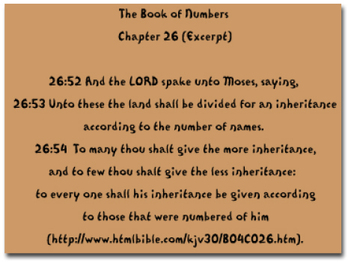According to cnn.com, the Italian lottery company Lottomatica has funded a $322,263 restoration project of Michelangelo’s “Moses.” Created between 1514 and 1516, almost five hundred years of dirt will be dusted off “Moses” by the time the work of Antonio Forcellino, one of Italy’s most respected restorers, is finished. What makes this story most interesting is that the restoration of “Moses” will be paid with monies raised by lotteries. This is not the first time lottery funds have been used for public projects. In fact, a history of lotteries as well as the emergent funds points to the worldwide popularity and utility of lotteries throughout the ages. The story begins when Moses was more mortal and less stone.
According to the North American Association of State and Provincial Lotteries (NASPL), some biblical scholars allege that Moses used a lottery to award land to his followers. The following excerpt from
Chapter 26 in the Book of Numbers might be one example of this.
Even before Christ, specifically 100 BC, the Hun Dynasty in China purportedly financed the construction of the Great Wall of China with monies received through lotteries (NASPL). Almost fifteen hundred years later in 1446, the Flemish artist Jan van Eyck raffled paintings through one of the first lotteries in Europe (NASPL). One hundred years after this in 1567, Queen Elizabeth I created the English lottery with 400,000 tickets to sell and prizes that ranged from cash to tapestries (NASPL). King James I of England was quick to follow Elizabeth I when in 1612 he created a lottery in London implemented to support Jamestown, VA, the first British colony in the United States (NASPL).
In the mid to late 1700’s, America’s founding fathers utilized state-sponsored lotteries for a variety of different fundraising purposes. Indeed, playing the lottery was considered an exercise in civic responsibility (Clotfelter & Cook, 1989, in Dunstan, 1997). Benjamin Franklin financed cannons for the Revolutionary War through lotteries, while George Washington used lottery proceeds to construct the Mountain Road that opened expansion into the West from Virginia (NASPL). Some of the nation’s first and most prestigious universities (e.g., Yale, Columbia, Dartmouth, Princeton, and Harvard) were founded with funds raised through lotteries (Dunstan, 1997).
While lotteries were used by many states in America throughout much of the 1800’s to finance public construction projects such as hospitals, courthouses, and libraries, they were simultaneously scrutinized due to the alleged harm some felt would come to those who participated (NASPL). Finally, these concerns dominated public policy. In the 1820’s, New York was the first state in America to constitutionally prohibit lotteries (NASPL). In addition, the United States Congress banned all material pertaining to lotteries from both the mail and interstate commerce in 1890 and 1895 respectively (NASPL). In 1905, the U.S. Supreme Court restated the right of all states in the Union to manage gambling by use of police power; in essence, this ruling prohibited lotteries in many states throughout America for the next six decades (NASPL).
In 1964, New Hampshire created the first modern legal lottery in the United States by linking it to horse racing; this evaded the existing U.S. laws opposing lotteries (NASPL). New York and New Jersey quickly followed New Hampshire by implementing a state lottery in 1967 and 1970 respectively (NASPL). Canadian lotteries in Quebec and Manitoba soon followed (NASPL).
By 1973, lottery sales from around the world reached $500 million (NASPL). With the introduction of the first “scratch-off” lottery ticket in Massachusetts in 1974 and lottery advertisements on television in 1975, lottery sales soared passed $1billion dollars in 1976 (NASPL). Today, thirty-seven states in America operate a lottery, and lotteries remain legal throughout Canada (NASPL). Moreover, national lotteries exist in France and Japan, and there is at least one lottery on each of the world’s continents except for Antarctica (International Association of State Lotteries, in NASPL). Indeed, the financial benefits of lotteries for both participants and vendors suggest that lotteries will remain a social and cultural fixture throughout the world. Scientists have the opportunity to develop and implement longitudinal research that focuses on the totality of lotteries (i.e., their construction, maintenance, players, and purveyors). These investigations will provide insight into the potential consequences associated with the continued worldwide success of lotteries.
References
Dunstan, R. (1997). Gambling in California (CRB-97-003). California Research Bureau. Available: http://www.library.ca.gov/CRB/97/03/crb97003.html
The Holy Bible. King James Version. Available: http://www.htmlbible.com/kjv30/index.htm
NASPL. Lottery History. Available: http://www.naspl.org/history.html
The WAGER is a public education project of the Division on Addictions at Harvard Medical
School. It is funded, in part, by the National Center for Responsible Gaming, the
Massachusetts Department of Public Health, the Addiction Technology Transfer Center of
New England, the Substance Abuse and Mental Health Services Administration, and the
Center for Substance Abuse Treatment.





